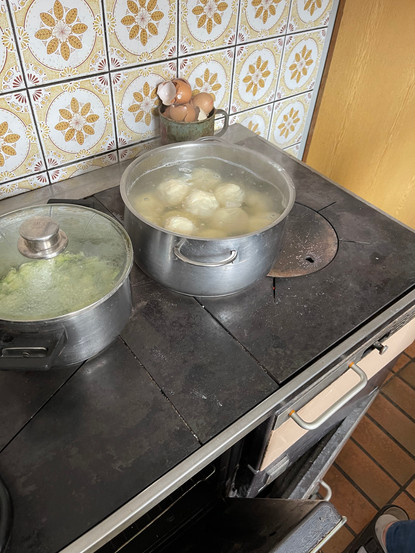Life in Austria as I Know it Through IFYE
- Sophie Cole

- Aug 18, 2022
- 5 min read
A great benefit of the IFYE program is that you get to experience many unique aspects of the host country’s culture. Traveling as a tourists to a foreign country, you really just scratch the surface. But with an exchange program, you get the immerse yourself in the life of your host country. Staying with host families allows for direct knowledge of the cultural norms and connections to cultural events & experiences. During my travels with the IFYE program, I learned so much about daily life in Austria, and there are so many aspects of life that I could discuss! Some aspects being unique to the host family or to the region of the country, but some aspects that have been common through-out my experience. Some common aspects of life that I have gotten to learn in great amounts have been - food, agriculture, and leisure activities.
Food in Austria
Food has been a big part of my exchange. With every family I have gotten to try new foods, learn new recipes, see new ways of reducing food waste, eat at different restaurants, and share different recipes of my own. For Austria being a “meat and potatoes” country, I also enjoyed lots of breads, fruits, vegtables, and of course many different kinds of cakes and ice cream. A traditional Austria breakfast normally consists of Semmel (a type of bread) & sliced ham and/or cheese , however a typical breakfast I had was yogurt with oats and marmalade, or sliced bread with marmalade. Snacks are often sweet breads or cakes, or a fresh vegetable from the garden. Lunch is typically the largest meal of the day. It is also almost always a hot meal and traditionally includes a soup as an appetizer. It is also not un-common for there to be served a hot sweet tasting meal for lunch - like apfelstrudel or Merrillenknödel. Desert and/or coffee was normally served once lunch was finished. Coffee typically served hot with breakfast and could be either hot or iced in the afternoon. Dinner is typically smaller and served cold. I normally enjoyed sliced bread with a variety of different cheeses, meats, and fresh garden vegetables. Drinks also a big part of food culture, I enjoyed many wine spritzers and locally brewed beers. Beer is also mixed with lemonade to make a delicious radler. Tap water is also safe to drink almost anywhere in Austria (almost all water sources are exclusively from the Alps). Carbonated water is also popular, and elderflower syrup can be added to either still or sparkling water. Well known Austrian foods I grew to love were käsekriainer and schnitzel. A käsekriainer is a sasusage filled with cheese and a schnitzel is a thin slice of chicken or pork that is fried with breading. Let’s just say, I never starved during my stay in Austria.
Agriculture in Austria
Half of my trip has been spent staying on farms and the other half with families involved with agriculture in other ways. My host families that owned and operated farms have all been dairy farmers. Dairy is the most common farming operation in Austria. A small dairy farmer normally owns around 5 - 15 cows, while a large dairy farmer owns 30 - 60 cows. Smaller farmers normally have other part time jobs, but owners of a large farm only focus on the cows. Being able to produce their own milk allows the farmers to keep some for themselves. This milk is often used for beverages like coffee or made into foods such as yogurt, cheese, and butter - all at home! Small and large dairy farmers typically sell their milk product to a dairy factory. Trucks operated by these dairy factories come to the farmers to collect the milk from their tank. Depending on the dairy farmer they may also allow for direct sale to the consumer. The cows are typically fed silage that is produced also by the farmer on their land. It was common for farmers with larger areas of land to also own and manage forest lands. Farm lands are often passed down from generation to generation, with parents continuing to help the current generation with farm work. It is common for farming households to have grand-parents, parents, and children live in the same house. I found that many crops are organic and that many fields have a complex irrigation system. Gardening is also very common. All of the gardening that I experienced with each family kept all of their product for themselves. Most common garden fruits and vegetables I encountered were apples, cucumbers, beans, tomatoes, potatoes, carrots, raspberries, red current, blackberries, and apricots. Some of these garden foods eaten fresh or combined into meals, and others were made into sauces and marmalades to be used throughout the year. Other farm animals that I encountered besides dairy cows were horses, dogs, cats, pigs, chickens, rabbits, and bees. All animals treated as companions. Some animals serving as good consumers of human food waste and some animals raised for consumption. All aspects of agriculture were shown to be valued by everyone.
Leisure Activities in Austria
The most popular and most fun way to spend a weekend in Austria is at a festival. Nearly every
weekend that I was in Austria, there was a local festival to attend. Some festivals only lasting one afternoon on a Saturday, while others ran all weekend Friday - Sunday. All events were named after its significance - name of the village, name of the location, name of the band, or term for the main attraction. Some festivals were markers for a special time in the season - like the beginning of summer. Many if not all local festivals are annual events for the villages. These festivals are always free admission and typically always involve some kind of music, dancing or games, and bbq & beer. Festivals are normally also fundraisers for the community and often operated by a local fire brigade, local brass music group, or local dance club. Many times raffle prizes were used as fundraisers and included grand prizes. Traditional and modern music involved an accordion in the band. Games and attractions often tailored to children and larger festivals brought carnival rides. Dancing at the festival depended on the music. Traditional music paired with folk dancing - circle dance, waltz, and polka. It was not un-common for attendees to wear a traditional dress - lederhosen for men and dirndl for women; however you can also come as you are in street clothes. Food served is always cooked on site and typically the event was well organized with waiters to the tables. Bar tents were also common and normally always separated into two - a beer bar and a hard liquor “schnapps” bar. If wine was served it would have its own separate place as well. There was never a dull moment at a festival!













































































































































Comments